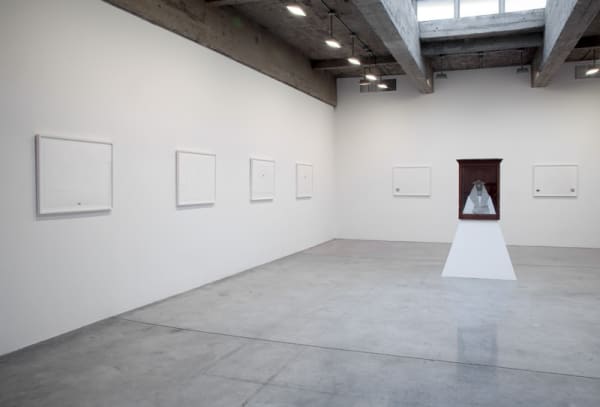Tanya Bonakdar Gallery is pleased to present a solo exhibition of new work by Peggy Preheim, entitled the end (final cut). The exhibition will feature a remarkable selection of the artist's exquisite graphite pencil drawings and enigmatic sculptural compositions.
Through intense and intimate renderings of imagery inspired by early found photographs, Preheim explores the passing of time in two dimensions, both historical and mythological. These meticulous and eloquent drawings evoke ideas about our own relationship to the past and future with haunting images inspired by and modified from their disparate sources. For example, in Near Miss 2, the ancient symbol of the Aztec calendar on the Mexican peso note references mythological time, while images of the U.S. founding fathers on the two-dollar bill symbolize secular time and our American collective history. In Cornerstone, half of a twenty dollar bill is featured on the lower right side of the paper, while a quietly rendered image of a buffalo graces the opposite end of the page, alluding to the Trail of Tears and Andrew Jackson's role in this expulsion. Using personal, found, and historical photographic sources, Preheim investigates the mythmaking aspects of photography; how images signify the passing of time, and in the context of a vintage photograph, how they take on new meaning for modern viewers.
In several works, Preheim makes collage from currency, destroying the traditional worth of this symbolic paper. At the same time, the artist evokes questions about value: personal, social, and artistic. In Snow White, a bald eagle flys overhead while Jackson, his portrait framed and contained in a twenty dollar bill with the American flag removed, watches from below. Using found images from currency notes, normally overlooked due to its mass-reproduction, Preheim isolates and forces us to consider the imagery of, for example, the all-seeing "Eye of Providence," a portrait of Debussy on the French franc, the Aztec calendar, etc. She calls our attention to iconic myths, long-held social and political beliefs, and ancient philosophies that have informed and bound nations. Through these sophisticated appropriations and revealing juxtapositions, Preheim explores "the cyclical nature of human experience."
In her sculptures, air-dried clay glows with a luminescence brighter than marble or plaster. These delicate, enigmatic works allude to privacy and intimacy, as well as art history, including Bellmer, Bourgeois or De Chirico. However Preheim's characters are imbued with implied history and more intimate emotions than their automaton predecessors. Malformed heads and boneless bodies convey a fragile, innocent, and sometimes psychologically disturbing message. In L'Appel, a medium sized head rests under a glass dome with a small circular opening on top. A headdress made of ticking fabric covers the dome, poetically referencing Egyptian royalty. The sculptures are presented behind bell jars or glass cases like memories - contained, protected and preserved.
Peggy Preheim lives and works in New York. Her work was the subject of a one-person exhibition at the Aldrich Contemporary Art Museum in Ridgefield, Connecticut, entitled Little Black Book, which traveled between 2008-2010 to the Philbrook Museum of Art, Tulsa, Oklahoma and to the Herbert F. Johnson Museum, Cornell University, Ithaca, NY. A hardcover catalog was published in conjunction with the exhibition. Other past exhibitions include New Directions in American Drawing, The Columbus Museum, Columbus, Georgia, which traveled to the Telfair Museum, Savannah, Georgia and the Knoxville Museum of Art, Tennessee, 2007-08 (group); and Transitional Objects: Contemporary Still Life, Neuberger Museum, Purchase, New York, 2006 (group). Preheim's work is included in the collections of the Albright-Knox Art Gallery, Buffalo, NY, Brooklyn Museum of Art, Museum of Fine Arts, Houston, TX, The Museum of Modern Art, NY, and the Whitney Museum of American Art, among others.
All installation images above: Photo by Jean Vong







